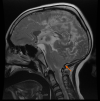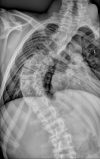Chiari malformations in children: An overview
- PMID: 33585622
- PMCID: PMC7852648
- DOI: 10.12998/wjcc.v9.i4.764
Chiari malformations in children: An overview
Abstract
Chiari malformations encompass various radiological and clinical entities, sharing the herniation of the rhombencephalic structures through the foramen magnum as a common characteristic. They can be symptomatic or asymptomatic. The therapeutic strategies for these malformations differ on the basis of the diverse pathophysiologic processes that cause them. As Chiari malformations are caused by various pathophysiologic processes, they must be recognized promptly to select the best treatment for each single case.
Keywords: Chiari malformation; Craniocervical junction; Foramen magnum; Hydrocephalus; Intracranial pressure; Treatment.
©The Author(s) 2021. Published by Baishideng Publishing Group Inc. All rights reserved.
Conflict of interest statement
Conflict-of-interest statement: The authors of this manuscript having no conflicts of interest to disclose.
Figures











References
-
- Chiari H. Concerning alterations in the cerebellum resulting from cerebral hydrocephalus. 1891. Pediatr Neurosci. 1987;13:3–8. - PubMed
-
- McLone DG, Knepper PA. The cause of Chiari II malformation: a unified theory. Pediatr Neurosci. 1989;15:1–12. - PubMed
-
- Thompson DNP. Chiari I-a 'not so' congenital malformation? Childs Nerv Syst. 2019;35:1653–1664. - PubMed
-
- Pueyrredon F, Spaho N, Arroyave I, Vinters H, Lazareff J. Histological findings in cerebellar tonsils of patients with Chiari type I malformation. Childs Nerv Syst. 2007;23:427–429. - PubMed
Publication types
LinkOut - more resources
Full Text Sources
Other Literature Sources
Research Materials

